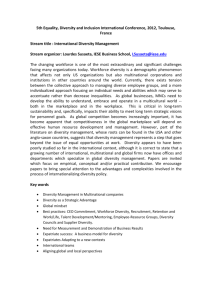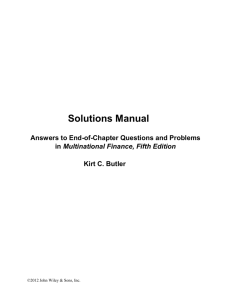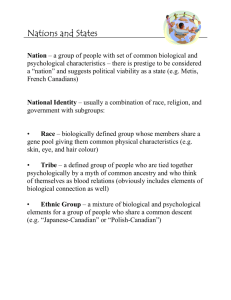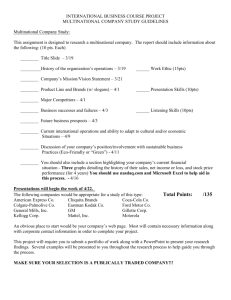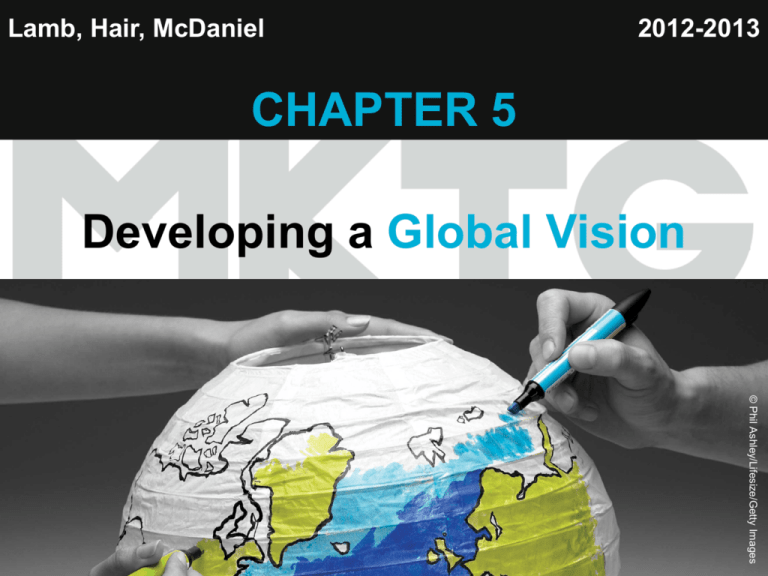
Lamb, Hair, McDaniel
2012-2013
CHAPTER 5
Developing a Global Vision
Copyright ©2012 by Cengage Learning Inc. All rights reserved
1
© Phil Ashley/Lifesize/Getty Images
Chapter 1
Learning Outcomes
1
Discuss the importance of global
marketing
2
Discuss the impact of multinational firms
on the world economy
3
Describe the external environment facing
global marketers
2
Learning Outcomes
4
Identify the various ways of entering the
global marketplace
5
List the basic elements involved in
developing a global marketing mix
6
Discover how the Internet is affecting
global marketing
3
Rewards of Global Marketing
Discuss the
importance of
global marketing
1
4
Rewards of Global Marketing
Having a global vision means…
• Recognizing and reacting to international
marketing opportunities
• Using effective global marketing
strategies
• Being aware of threats from foreign
competitors
5
1
Importance of Global
Marketing to the U. S.
Derives 12 % of gross domestic product
(GDP) from world trade
7 % of U.S. employment is supported by
exports
U.S. businesses export over $1.7 trillion in
goods and services annually
More small companies are aggressively
pursuing international markets
6
1
Globalization Issues
Millions of Americans have lost jobs due to:
Imports
Outsourcing
Millions more fear losing jobs
Pay cuts: accept or firms will outsource
Sectors that are vulnerable:
Service
White collar
Production
7
1
Globalization Benefits
Expands economic freedom
Spurs competition
Raises productivity and living standards
Offers access to foreign capital, global export
markets, and advanced technology
Promotes higher labor and environmental
standards
Acts as a check on governmental power
8
1
Multinational Firms
Discuss the impact of
multinational firms on
the world economy
2
9
Multinational Corporation
A company heavily engaged in international
trade, beyond exporting and importing.
A multinational corporation moves resources,
goods, services and skills across national
boundaries without regard to the country in
which its headquarters are located.
Source: MKT 4
10
2
Multinational Firms
Multinational Corporation: A company
that manufactures and markets products
in many different countries and has
multinational stock ownership and
management. (not just trade)
Source: Understanding Business
11
2
Multinational Firms
Note: Not all large global businesses are
multinational. Only firms that have
manufacturing capacity or some other
physical presence in different nations can
truly be multinational.
Source: Understanding Business
12
2
Stages of Global
Business Development
13
1
Companies operate in one country and
sell into others
2
Set up foreign subsidiaries to handle sales
3
Operate an entire line of business in
another country
4
Virtual operation
2
Are Multinationals Beneficial?
•
•
•
•
14
Pros
Account for 19 % of U.S.
private sector jobs
Provide 25 % of private
sector wages
Account for 74 % of R&D
spending
AND 48% of total exports
Cons
• Technology is capital
intensive and does not
necessarily increase
employment.
• Support governments that
benefit the company, not
necessarily the country
and its people
• May take away more
wealth than they generate
2
Global Marketing
Standardization
15
Global Marketing
Standardization
Production of uniform
products that can be sold the
same way all over the world.
Multidomestic
Strategy
Subsidiaries of multinational
firms are allowed to compete
independently in domestic
markets.
2
External Environment Facing
Global Marketers
Describe the external
environment facing
global marketers
3
16
External Environment Facing
Global Marketers
1-Culture
4-Demographic
Makeup
2-Economics
5-Natural
Resources
3-Political
and Legal
17
3
1-Culture
The common set of values shared by its citizens
that determine what is socially acceptable
Factors to keep in mind when dealing with
different cultures:
1. Language and cultural idioms
2. Customs and traditions
3. Values and expectations of sales presentations
18
3
2-Economic Development
19
Developed
Country
Complex, sophisticated
industries
Less Developed
Country
Basic industries
3
Economic Development:
China and India
• China and India have two of the highest
growth rates in the world
• Have the world’s two largest populations
• Among highest levels of income disparity
• Great linguistic and cultural diversity
20
3
3-Political and Legal
21
Tariff
A tax levied on goods entering
a country
Quota
Limit on the amount of a
product entering a country
Boycott
Exclusion of products from
a country
Exchange Control
Foreign exchange must be
sold to a control agency
Market Grouping
Common trade alliance
Trade Agreement
An agreement to stimulate
international trade
3
Political and Legal
The Uruguay Round made changes
in world trading practices
Entertainment, pharmaceuticals,
integrated circuits, and software
Financial, legal, and accounting services
Agriculture
Textiles and apparel
And created a new trade organization:
The World Trade Organization
22
3
Political and Legal
Agreements
and Organizations
CAFTA
23
NAFTA
European
Union
3
Doha Round
• Began in 2001
• Highly contentious from the beginning
• Stalemate over lowering tariffs on
industrial goods in exchange for cutting
U.S. farm subsidies.
• More protectionism has made talks
increasingly difficult
24
3
4-Demographics &
5- Resources
Demographic Considerations:
•
•
•
Population density
Urban or rural
Age of population
Natural Resource Considerations:
•
•
•
•
•
25
International dependencies
Shifts of wealth
Inflation & recession
Export opportunities if resources are abundant
Stimulus for military intervention
3
Global Marketing by the Individual Firm
Identify the various
ways of entering the
global marketplace
4
26
Why “Go Global”?
Earn additional profits
Leverage a unique product or
technological advantage
Possess exclusive market information
Saturated domestic markets
Excess capacity
Utilize “economies of scale”
27
4
Exhibit 5.3
Risk Levels for Five Methods of Entering
the Global Marketplace
28
© 2013 by Cengage Learning Inc. All Rights Reserved.
Entering the Global Marketplace
29
Exporting
Selling domestically produced
products to buyers in other countries
Licensing
Legal process allowing use of
manufacturing/patents/knowledge
Contract
Manufacturing
Private-label manufacturing
by a foreign country
Joint Venture
Domestic firm buys or joins a foreign
company to create a new entity
Direct Investment
Active ownership of a foreign
company or manufacturing facility
4
Export Intermediaries
30
Buyer for Export
Assumes all ownership risks and
sells globally for its own account.
Export Broker
Plays the traditional broker’s role by
bringing buyer and seller together.
Export Agent
Acts like a manufacturer’s agent for
the exporter in the foreign market.
4
The Global Marketing Mix
List the basic elements
involved in developing
a global marketing mix
5
31
The Global Marketing Mix
The first step in creating a marketing mix is
developing a thorough understanding of the
global target market…
HOWEVER
…global marketing research is
conducted in vastly different environments.
32
5
Product and Promotion
Same
Message
Change
Message
33
Same
Product
Change
Product
One Product
One Message
Product
Adaptation
Promotion
Adaptation
Product
Invention
5
Place (Distribution)
Adequate distribution is necessary for
success in global markets
Lack of distribution infrastructure and
cultural differences create problems
Logistics and shipping costs have been a
growing challenge for U.S. companies
looking to move production overseas.
Global trade has added to strains and
charges for all forms of transportation.
34
5
Pricing
Must consider transportation and
insurance costs, taxes and tariffs
(exchange rates)
Determine what customers will spend
Ensure that foreign buyers
will pay the price
May need to simplify a product
to lower price
Don’t assume that low-income
countries will accept lower quality
35
5
Exchange Rates
The price of one country’s currency in
terms of another country’s currency.
Floating Exchange Rates
A system in which prices of different currencies
move up and down based on the demand for and
the supply of each currency.
36
5
Dumping
Dumping: the sale of an exported product at a
price lower than that charged for the same product in
the “home” market of the exporter. Dumping may
occur as a result of exporter strategies including:
37
Trying to increase an overseas market share
Temporarily distributing products to overseas markets
to offset slack demand at home
Lowering costs by exploiting large-scale production
Attempting to maintain stable prices during periods of
exchange rate fluctuations
5
Countertrade
Countertrade
A form of trade in which all or
part of the payment for goods
or services is in the form of
other goods or services.
38
5
The Impact of the Internet
Discover how the
Internet is affecting
global marketing
6
39
The Impact of the Internet
http://www.youtube.com/watch?v=QzZyUaQvpdc&feature=related
• Opening an e-commerce site puts a company
in the international marketplace
• The Internet economy is still affected by old
(brick & mortar) rules, regulations, and habits
40
6

